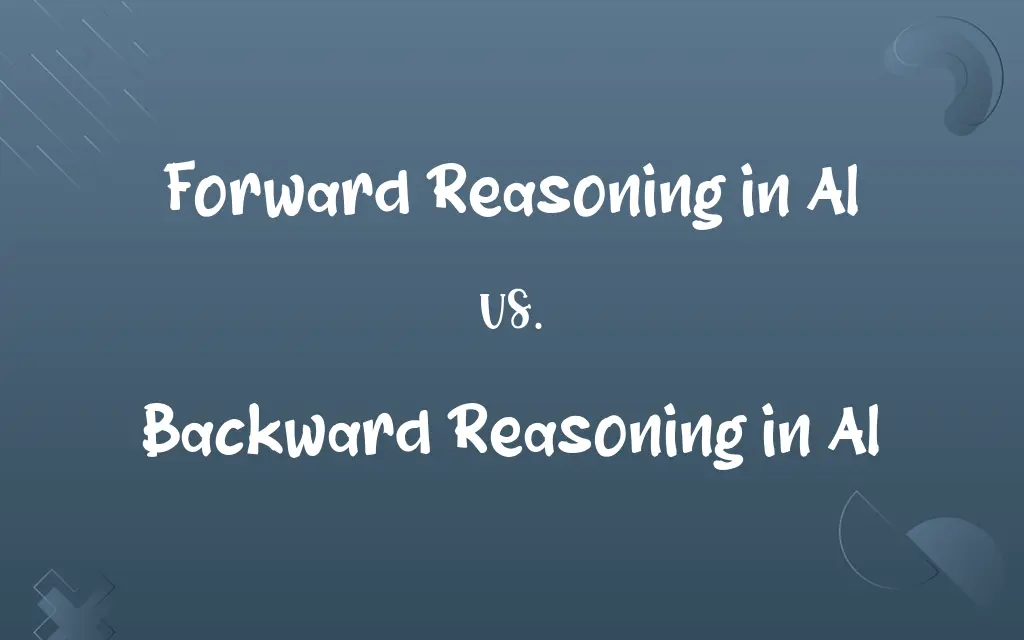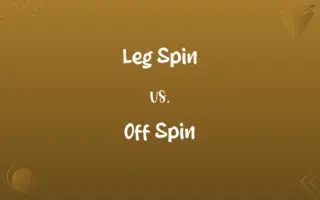Forward Reasoning in AI vs. Backward Reasoning in AI: Know the Difference

By Shumaila Saeed || Published on February 6, 2024
Forward reasoning in AI involves deducing logical consequences from initially known facts. Backward reasoning in AI starts with a hypothesis and works backward to find supporting facts.

Key Differences
Forward Reasoning in AI is a logical process where conclusions are drawn from known facts or premises. This method moves from the general to the specific, deriving new information or conclusions from what is already known. In contrast, Backward Reasoning in AI begins with a specific goal or conclusion and works backwards to find the necessary facts or premises that support this conclusion. This approach is often used in problem-solving situations where the end goal is known but the path to reach it is not.
Shumaila Saeed
Feb 06, 2024
In Forward Reasoning in AI, the approach is typically data-driven, meaning it starts with detailed data and moves towards a more general conclusion. It's akin to assembling a puzzle by placing each piece based on the existing layout. Backward Reasoning in AI, on the other hand, is goal-driven. It starts with an idea of what the completed puzzle should look like and works backwards to find the pieces that fit this picture.
Shumaila Saeed
Feb 06, 2024
Forward Reasoning in AI is often used in situations where all relevant information is available and the aim is to explore all possible conclusions. This method is exhaustive in nature, exploring all avenues of reasoning. In contrast, Backward Reasoning in AI is more selective, focusing only on pathways that could potentially lead to the desired conclusion, making it efficient in scenarios where the final goal is clear but the means to achieve it are not.
Shumaila Saeed
Feb 06, 2024
Forward Reasoning in AI aligns with deductive reasoning, where the derived conclusions are logically guaranteed by the initial premises. It's systematic and comprehensive but can be time-consuming in complex scenarios. Backward Reasoning in AI aligns more with inductive reasoning, starting with specific instances and working towards a general understanding, often used in diagnostic processes, where specific symptoms are traced back to possible causes.
Shumaila Saeed
Feb 06, 2024
In Forward Reasoning in AI, the process is often transparent and easy to follow, as it builds step-by-step from known facts. However, it can lead to exploring irrelevant paths. Backward Reasoning in AI is more focused and can quickly eliminate irrelevant paths, but it may require assumptions about the end goal that are not always evident, making the process less transparent.
Shumaila Saeed
Feb 06, 2024
ADVERTISEMENT
Comparison Chart
Starting Point
Begins with known facts or data
Begins with a hypothesis or desired conclusion
Shumaila Saeed
Feb 06, 2024
Direction of Reasoning
Moves from general to specific
Moves from specific to general
Shumaila Saeed
Feb 06, 2024
Nature of Process
Data-driven, exploring all possible outcomes
Goal-driven, focusing on paths leading to the specific conclusion
Shumaila Saeed
Feb 06, 2024
Type of Reasoning
More aligned with deductive reasoning
More aligned with inductive reasoning
Shumaila Saeed
Feb 06, 2024
Efficiency in Complex Scenarios
Can be time-consuming due to exploring all avenues
More efficient by focusing on relevant paths only
Shumaila Saeed
Feb 06, 2024
ADVERTISEMENT
Forward Reasoning in AI and Backward Reasoning in AI Definitions
Forward Reasoning in AI
Forward Reasoning in AI is a method of drawing specific conclusions from general knowledge.
In Forward Reasoning, an AI system deduces that a car needs refueling based on its understanding of fuel consumption patterns.
Shumaila Saeed
Jan 24, 2024
Backward Reasoning in AI
Backward Reasoning in AI starts with a hypothesis and traces back to find supporting facts.
Using Backward Reasoning, an AI system determines the causes of a car's engine failure by starting with the failure itself.
Shumaila Saeed
Jan 24, 2024
Forward Reasoning in AI
It involves systematically applying rules to initial facts to reach conclusions.
A Forward Reasoning AI program determines that a patient has a cold based on symptoms like coughing and a sore throat.
Shumaila Saeed
Jan 24, 2024
Backward Reasoning in AI
It involves working backwards from a goal to identify the necessary steps to achieve it.
An AI chess program uses Backward Reasoning to determine the moves needed to achieve checkmate from a given board position.
Shumaila Saeed
Jan 24, 2024
Forward Reasoning in AI
Forward Reasoning in AI is a logical progression from known conditions to deduce new information.
Using Forward Reasoning in AI, a weather prediction system deduces that it will rain by analyzing current atmospheric conditions.
Shumaila Saeed
Jan 24, 2024
ADVERTISEMENT
Backward Reasoning in AI
Backward Reasoning in AI is a goal-driven process, focusing on deducing prerequisites of a desired outcome.
To diagnose an illness, an AI system applies Backward Reasoning by starting with symptoms and working back to potential diseases.
Shumaila Saeed
Jan 24, 2024
Forward Reasoning in AI
This approach entails a step-by-step logical deduction from given premises.
An AI uses Forward Reasoning to predict stock market trends by analyzing historical data patterns.
Shumaila Saeed
Jan 24, 2024
Backward Reasoning in AI
This method reverse-engineers a problem to understand its underlying causes.
An AI uses Backward Reasoning to backtrack from a cyber breach to identify how the security was compromised.
Shumaila Saeed
Jan 24, 2024
Forward Reasoning in AI
Forward Reasoning in AI is about deriving implicit facts from explicit knowledge.
An AI using Forward Reasoning concludes that a plant needs watering from data about soil dryness and weather conditions.
Shumaila Saeed
Jan 24, 2024
Backward Reasoning in AI
Backward Reasoning in AI is about inferring the conditions necessary for a known conclusion.
In solving a murder mystery, an AI uses Backward Reasoning to figure out the sequence of events leading to the crime.
Shumaila Saeed
Jan 24, 2024
Repeatedly Asked Queries
What is an example of Forward Reasoning in AI?
An AI predicting weather changes based on current atmospheric data.
Shumaila Saeed
Feb 06, 2024
Is Forward Reasoning in AI efficient?
It can be comprehensive but sometimes inefficient due to exploring all possibilities.
Shumaila Saeed
Feb 06, 2024
How does Forward Reasoning in AI work?
It works by applying a set of rules to known information to derive new conclusions.
Shumaila Saeed
Feb 06, 2024
What is the main characteristic of Forward Reasoning in AI?
Its main characteristic is progressing from general known facts to specific conclusions.
Shumaila Saeed
Feb 06, 2024
Is Backward Reasoning in AI goal-oriented?
Yes, it's inherently goal-oriented, focusing on achieving a specific outcome.
Shumaila Saeed
Feb 06, 2024
What is Forward Reasoning in AI?
It's a process where AI deduces logical consequences from known facts or initial data.
Shumaila Saeed
Feb 06, 2024
How is Backward Reasoning in AI different from Forward Reasoning?
It differs in starting with a hypothesis or goal and working backwards, unlike Forward Reasoning which starts with facts.
Shumaila Saeed
Feb 06, 2024
Can Forward Reasoning in AI handle complex situations?
Yes, but it may become time-consuming as complexity increases.
Shumaila Saeed
Feb 06, 2024
In what scenarios is Forward Reasoning in AI preferable?
It's preferable in scenarios where all possible outcomes need to be explored.
Shumaila Saeed
Feb 06, 2024
Is Backward Reasoning in AI limited in any way?
Its limitation lies in potentially requiring assumptions about the end goal.
Shumaila Saeed
Feb 06, 2024
Can Backward Reasoning in AI be used in diagnostics?
Yes, it's particularly effective in diagnostic applications where the end goal is known.
Shumaila Saeed
Feb 06, 2024
What's an example of Backward Reasoning in AI?
An AI system diagnosing a disease by starting with symptoms and identifying potential causes.
Shumaila Saeed
Feb 06, 2024
Which is more efficient, Forward or Backward Reasoning in AI?
Backward Reasoning is often more efficient as it focuses only on relevant paths.
Shumaila Saeed
Feb 06, 2024
How does Backward Reasoning in AI handle unknown goals?
It's less effective with unknown goals, as it relies on having a specific conclusion in mind.
Shumaila Saeed
Feb 06, 2024
Can Forward Reasoning in AI be data-driven?
Yes, it's primarily data-driven, starting from detailed facts towards broader conclusions.
Shumaila Saeed
Feb 06, 2024
What is Backward Reasoning in AI?
It's a method where AI starts with a desired outcome and works backwards to find supporting evidence.
Shumaila Saeed
Feb 06, 2024
Does Backward Reasoning in AI use deductive reasoning?
It aligns more with inductive reasoning, starting with specific instances to reach general conclusions.
Shumaila Saeed
Feb 06, 2024
What type of reasoning does Forward Reasoning in AI represent?
It represents deductive reasoning, moving from general premises to specific conclusions.
Shumaila Saeed
Feb 06, 2024
Can Backward Reasoning in AI be used in problem-solving?
Absolutely, especially in problems where the end goal is clear but the path to it is not.
Shumaila Saeed
Feb 06, 2024
How does Forward Reasoning in AI contribute to AI learning?
It contributes by enabling AI systems to build upon existing knowledge and derive new insights.
Shumaila Saeed
Feb 06, 2024
Share this page
Link for your blog / website
HTML
Link to share via messenger
About Author
Written by
Shumaila SaeedShumaila Saeed, an expert content creator with 6 years of experience, specializes in distilling complex topics into easily digestible comparisons, shining a light on the nuances that both inform and educate readers with clarity and accuracy.




































































